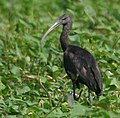Ibis
| Ibis | |
|---|---|

| |
| Black-headed ibis (Threskiornis melanocephalus) | |
| Scientific classification | |
| Domain: | Eukaryota |
| Kingdom: | Animalia |
| Phylum: | Chordata |
| Class: | Aves |
| Order: | Pelecaniformes |
| Family: | Threskiornithidae |
| Subfamily: | Threskiornithinae Poche, 1904 |
| Type genus | |
| Threskiornis G.R. Gray, 1842
| |
| Genera | |
The ibis (/ˈaɪbɪs/) (collective plural ibises;[1] classical plurals ibides[2][3] and ibes[3]) are a group of long-legged wading birds in the family Threskiornithidae that inhabit wetlands, forests and plains.[4] "Ibis" derives from the Latin and Ancient Greek word for this group of birds. It also occurs in the scientific name of the western cattle egret (Ardea ibis) mistakenly identified in 1757 as being the sacred ibis.[5]
Description
Ibises all have long, downcurved bills, and usually feed as a group, probing mud for food items, usually crustaceans. They are monogamous and highly territorial while nesting and feeding.[4] Most nest in trees, often with spoonbills or herons. All extant species are capable of flight, but two extinct genera were flightless, namely the kiwi-like Apteribis in the Hawaiian Islands, and the peculiar Xenicibis in Jamaica.[4] The word ibis comes from Latin ibis[6] from Greek ἶβις ibis from Egyptian hb, hīb.[7]
Species in taxonomic order
There are 29 extant species and 4 extinct species of ibis.
| Image | Genus | Living species |
|---|---|---|
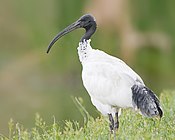 |
Threskiornis G.R. Gray, 1842 |
|
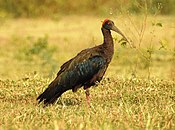 |
Pseudibis Hodgson, 1844 |
|
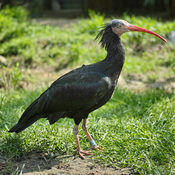 |
Geronticus Wagler, 1832 |
|
 |
Nipponia Reichenbach, 1850 |
|
 |
Bostrychia G.R. Gray, 1847 |
|
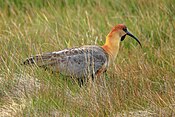 |
Theristicus Wagler, 1832 |
|
 |
Cercibis Wagler, 1832 |
|
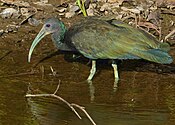 |
Mesembrinibis J.L. Peters, 1930 |
|
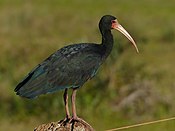 |
Phimosus Wagler, 1832 |
|
 |
Eudocimus Wagler, 1832 |
|
 |
Plegadis Kaup, 1829 |
|
 |
Lophotibis L. Reichenbach, 1853 |
|
 |
† Apteribis Olson & Wetmore, 1976 |
An extinct species, the Jamaican ibis or clubbed-wing ibis (Xenicibis xympithecus) was uniquely characterized by its club-like wings. Extinct ibis species include the following:
- Geronticus perplexus. Discovered in France. It is known only from a piece of distal right humerus, found at Sansan France, in Middle Miocene rocks. It appears to represent an ancient member of the Geronticus lineage, in line with the theory that most living ibis genera seem to have evolved before 15 million years ago (mya).[11]
- Geronticus apelex. Discovered in South Africa.[12]
- Geronticus balcanicus. Discovered in Bulgaria.[13]
- Theristicus wetmorei. Discovered in Peru.
- Eudodmus peruvianus. Discovered in Peru.
- Gerandibis pagana. Discovered in France.[14] It is the sole species known for this genera.[15]
- Aptertbis glenos. Discovered in Hawaii.
- Xenicibis xympithecus. Discovered in Jamaica.
Ecology
Habitat
Most ibises are freshwater wetland birds using natural marshes, ponds, lakes, riversides for foraging.[16] Some ibis species such as the white-faced ibis,[17] and black-headed ibis[18] benefit from flooded and irrigated agriculture. The Andean ibis is unusual in being found in high altitude grasslands of South America.[19] The foraging and nesting behaviour, and fluctuating numbers of the white ibis matches closely with water levels in the Everglades ecosystem leading to its selection as a potential indicator species for the system.[20] Few ibis species such as the olive ibis and green ibis are also found in dense forests. The Llanos grasslands of Venezuela have the highest global ibis diversity with seven species sharing the marshes and grasslands.[21] Multiple ibis species manage to use the same area by exhibiting differences in the habitats used and the prey eaten. In Indian agricultural landscapes, three ibis species manage to live together by altering the habitats they use seasonally with the Black-headed Ibises and Glossy preferring shallow wetlands throughout the year, while the endemic Red-naped Ibises preferred upland areas thereby entirely avoiding potential competitive interactions.[22]
Breeding
Ibises breeding habits are very diverse. Many ibises such as the black-headed Ibis, scarlet ibis, glossy ibis, American white ibis and Australian white ibis breed in large colonies on trees.[16] Nest trees are located either in large wetlands or in agricultural fields, with many species like the red-naped ibis breeding inside cities.[23] The Australian white ibis also breeds extensively inside cities and has greatly expanded its population.[24] The white-faced ibis sometimes nests on dry land and on low shrubs in marshes.[25]
In culture
The African sacred ibis was an object of religious veneration in ancient Egypt,[26] particularly associated with the deity Djehuty or otherwise commonly referred to in Greek as Thoth. He is responsible for writing, mathematics, measurement, and time as well as the moon and magic.[27] In artworks of the Late Period of Ancient Egypt, Thoth is popularly depicted as an ibis-headed man in the act of writing.[27] However, Mitogenomic diversity in sacred ibis mummies indicates that ancient Egyptians captured the birds from the wild rather than farming them.[28]
At the town of Hermopolis, ibises were reared specifically for sacrificial purposes, and in the Ibis Galleries at Saqqara, archaeologists found the mummies of one and a half million ibises.[29]
According to local legend in the Birecik area, the northern bald ibis was one of the first birds that Noah released from the Ark as a symbol of fertility,[30] and a lingering religious sentiment in Turkey helped the colonies there to survive long after the demise of the species in Europe.[31][32]
The mascot of the University of Miami is an American white ibis named Sebastian. The ibis was selected as the school mascot because of its legendary bravery during hurricanes. According to legend, the ibis is the last of wildlife to take shelter before a hurricane hits and the first to reappear once the storm has passed.[33]
Harvard University's humor magazine, Harvard Lampoon, uses the ibis as its symbol. A copper statue of an ibis is prominently displayed on the roof of the Harvard Lampoon Building at 44 Bow Street.
The short story "The Scarlet Ibis" by James Hurst uses the red bird as foreshadowing for a character's death and as the primary symbol.
The African sacred ibis is the unit symbol of the Israeli Special Forces unit known as Unit 212 or Maglan (Hebrew מגלן).
According to Josephus, Moses used the ibis to help him defeat the Ethiopians.[34]
The Australian white ibis has become a focus of art, pop culture, and memes since rapidly adapting to city life in recent decades, and has earned the popular nicknames "bin chicken" and "tip turkey".[35] In December 2017, the ibis placed second in Guardian Australia's inaugural Bird of the Year poll, after leading for much of the voting period.[36][37]
In April 2022, Queensland sports minister Stirling Hinchliffe suggested the ibis as a potential mascot for the 2032 Olympic Games, which are scheduled to be held in Brisbane.[38] Hinchcliffe's suggestion prompted much discussion in the media.[39][40][41]
Gallery
Notes
References
- ^ "ibis". Dictionary.com Unabridged. Retrieved 6 October 2009.
- ^ Fennell, C. A. M., ed. (1892). The Stanford dictionary of Anglicised words and phrases. Cambridge: Cambridge University Press. p. 453. OCLC 1354115. Retrieved 6 October 2009.
- ^ a b Pierce, Robert Morris (1910). Dictionary of Hard Words. New York: Dodd, Mead & Company. p. 270. OCLC 4177508. Retrieved 6 October 2009.
- ^ a b c Longrich, N. R.; Olson, S. L. (5 January 2011). "The bizarre wing of the Jamaican flightless ibis Xenicibis xympithecus: a unique vertebrate adaptation". Proceedings of the Royal Society B: Biological Sciences. 278 (1716): 2333–2337. doi:10.1098/rspb.2010.2117. PMC 3119002. PMID 21208965.
- ^ Jobling, James A (2010). The Helm Dictionary of Scientific Bird Names. London: Christopher Helm. p. 201. ISBN 978-1-4081-2501-4.
- ^ "ibis". Chambers Dictionary.
- ^ Beekes, R. S. P. (2009) Etymological Dictionary of Greek, Brill, p. 575. ISBN 9004174184.
- ^ David, Normand; Gosselin, Michel (2011). "Gender agreement of avian species-group names under Article 31.2. 2 of the ICZN Code" (PDF). Bulletin of the British Ornithologists' Club. 131 (2): 102–115. Retrieved 10 August 2017.
- ^ Schodde, Richard; Bock, Walter (2016). "Conflict resolution of grammar and gender for avian species-group names under Article 31.2. 2 of the ICZN Code: is gender agreement worth it?". Zootaxa. 4127 (1): 161–170. doi:10.11646/zootaxa.4127.1.9. PMID 27395618.
- ^ Dickinson, Edward C.; David, Normand; Alonso-Zarazaga, Miguel A. (2017). "Some comments on Schodde & Bock (2016) on gender agreement" (PDF). Bulletin of the British Ornithologists' Club. 137 (2): 142–144. doi:10.25226/bboc.v137i2.2017.a2. S2CID 125994321. Retrieved 10 August 2017.
- ^ Mlíkovský, Jirí (2002). Cenozoic Birds of the World (Part 1: Europe). Ninox Press, Prague. ISBN 80-901105-3-3.
- ^ Olson, S. L. (1985). "Early Pliocene ibises (Aves, Plataleidae) from south-western Cape Province, South Africa". Annals of the South African Museum. 97 (3): 57–69.
- ^ Boev, Zlatozar (1998). "Presence of Bald Ibises (Geronticus Wagler, 1832) (Threskionithidae - Aves) in the Late Pliocene of Bulgaria" (PDF). Geologica Balcanica. 28 (1–2): 45–52. doi:10.52321/GeolBalc.28.1-2.45.
- ^ Olson, Storrs L. (1981). "The generic allocation of Ibis pagana Milne-Edwards, with a review of fossil ibises (Aves: Threskiornithidae)". Journal of Vertebrate Paleontology. 1 (2): 165–170. Bibcode:1981JVPal...1..165O. doi:10.1080/02724634.1981.10011888. ISSN 0272-4634.
- ^ De Pietri, Vanesa L. (2013). Collinson, Martin (ed.). "Interrelationships of the Threskiornithidae and the phylogenetic position of the Miocene ibis ' Plegadis ' paganus from the Saint-Gérand-le-Puy area in central France". Ibis. 155 (3): 544–560. doi:10.1111/ibi.12062.
- ^ a b Hancock, James A.; Kushlan, James A.; Kahl, M. Philip (1992). Storks, Ibises and Spoonbills of the World. Academic Press, London.
- ^ Moulton, Colleen E.; Carlisle, Jay D.; Knetter, Sonya J.; Brenner, Kathryn; Cavallaro, Robert A. (2022). "Importance of flood irrigation for foraging colonial waterbirds". The Journal of Wildlife Management. 86 (7). Bibcode:2022JWMan..86E2288M. doi:10.1002/jwmg.22288. ISSN 0022-541X.
- ^ Sundar, K. S. Gopi (2006). "Flock Size, Density and Habitat Selection of Four Large Waterbirds Species in an Agricultural Landscape in Uttar Pradesh, India: Implications for Management". Waterbirds. 29 (3): 365–374. doi:10.1675/1524-4695(2006)29[365:FSDAHS]2.0.CO;2. ISSN 1524-4695.
- ^ Luzuriaga-Neira, Nivia; Ennis, Keenan; Moens, Michaël A. J.; Leon, Jose; Reyes, Nathaly; Luzuriaga-Neira, Agusto; Rau, Jaime R.; Rojas-VeraPinto, Roxana (2023). "The Andean Ibis (Theristicus branickii) in South America: potential distribution, presence in protected areas and anthropic threats". PeerJ. 11: e16533. doi:10.7717/peerj.16533. ISSN 2167-8359. PMC 10720468. PMID 38099301.
- ^ Frederick, Peter; Gawlik, Dale E.; Ogden, John C.; Cook, Mark I.; Lusk, Michael (2009). "The White Ibis and Wood Stork as indicators for restoration of the everglades ecosystem". Ecological Indicators. Indicators for Everglades Restoration. 9 (6, Supplement): S83 – S95. Bibcode:2009EcInd...9..S83F. doi:10.1016/j.ecolind.2008.10.012. ISSN 1470-160X.
- ^ Frederick, Peter C.; Bildstein, Keith L. (1992). "Foraging ecology of seven species of neotropical ibises (Threskiornithidae) during the dry season in the Llanos of Venezuela". The Wilson Bulletin. 104 (1): 1–21.
- ^ Ameta, Hitesh; Koli, Vijay Kumar; Sundar, K. S. Gopi (2024). "Is Three a Crowd? Three Indian Ibis Species Vary Strategies to Achieve Sympatry Depending on Different Seasons, Landscapes and Habitats". Waterbirds. 47 (1). doi:10.1675/063.047.0109. ISSN 1524-4695.
- ^ Mehta, Kanishka; Koli, Vijay K.; Kittur, Swati; Gopi Sundar, K. S. (2024). "Can you nest where you roost? Waterbirds use different sites but similar cues to locate roosting and breeding sites in a small Indian city". Urban Ecosystems. 27 (4): 1279–1290. Bibcode:2024UrbEc..27.1279M. doi:10.1007/s11252-023-01454-5. ISSN 1573-1642.
- ^ Martin, John; French, Kris; Major, Richard (2010). "Population and breeding trends of an urban coloniser: the Australian white ibis". Wildlife Research. 37 (3): 230–239. doi:10.1071/WR10047. ISSN 1448-5494.
- ^ Burger, Joanna (1977). "Colony and Nest Site Selection in White-Faced and Glossy Ibises". The Auk. 94 (4): 664–676. doi:10.2307/4085263. ISSN 0004-8038. JSTOR 4085263.
- ^ Ceram, C. W. (1967). Gods, Graves, and Scholars: The Story of Archaeology. Translated by Garside, E. B.; Wilkins, Sophie (2nd ed.). New York: Alfred A. Knopf. p. 207.
- ^ a b Birmingham Museum of Art (2010). Birmingham Museum of Art : guide to the collection. Birmingham Museum of Art. p. 65. ISBN 978-1-904832-77-5.
- ^ Wasef, Sally; Subramanian, Sankar; O’Rorke, Richard; Huynen, Leon; El-Marghani, Samia; Curtis, Caitlin; Popinga, Alex; Holland, Barbara; Ikram, Salima; Millar, Craig; Willerslev, Eske; Lambert, David (2019). "Mitogenomic diversity in Sacred Ibis Mummies sheds light on early Egyptian practices". PLOS ONE. 14 (11): e0223964. Bibcode:2019PLoSO..1423964W. doi:10.1371/journal.pone.0223964. PMC 6853290. PMID 31721774.
- ^ Fleming, Furgus; Alan Lothian (1997) The Way to Eternity: Egyptian Myth. Amsterdam: Time-Life Books. pp. 66–67
- ^ Shuker, Karl (2003). The Beasts That Hide from Man: Seeking the World's Last Undiscovered Animals. Cosimo. pp. 166–168. ISBN 1-931044-64-3. "Dreams of a feathered Geronticus"
- ^ Beintema, Nienke. "Saving a charismatic bird" (PDF). AEWA Secretariat. Archived from the original (PDF) on 1 March 2012. Retrieved 11 December 2008.
- ^ "Ancient Egyptians gathered birds from the wild for sacrifice and mummification: DNA study rejects the idea that Egyptians domesticated sacred ibis for ritual use". ScienceDaily. Retrieved 24 January 2020.
- ^ Sebastian the Ibis. Hurricane sports
- ^ Josephus. Antiquities of the Jews. 2.10.
- ^ Denby, Matthew (31 October 2020). "Secrets of the Ibis: The surprising real reason 'bin chickens' took Sydney by storm". Sydney Sentinel. Sydney. Retrieved 13 November 2020.
- ^ Langford, Sam (21 November 2017). "Bin Chickens Are Leading In Australia's Bird Of The Year Vote, And It's Time To Have Your Say". Junkee. Retrieved 17 January 2023.
- ^ Wahlquist, Calla (10 December 2017). "Magpie edges out white ibis and kookaburra as Australian bird of the year". The Guardian. Retrieved 17 January 2023.
- ^ McKay, Jack (4 April 2022). "Stirling Hinchliffe suggests ibis should be a contender for 2032 Games mascot". The Courier-Mail. Retrieved 24 July 2022.
- ^ Goodall, Hamish (4 April 2022). "Could the ibis - Australia's own 'bin chicken' - become the mascot for Brisbane 2032 Olympics? Queensland's sports minister believes so". Sunrise. Retrieved 24 July 2022.
- ^ Fordham, Ben (4 April 2022). "Bird expert backs ibis as the official mascot for Brisbane Olympics". 2GB. Retrieved 24 July 2022.
- ^ Horton, Shelly (4 April 2022). "'Come on - we can do better than the bin chicken for our Olympics mascot'". 9Honey. Retrieved 24 July 2022.
External links
- Ibis videos – at Internet Bird Collection
- . New International Encyclopedia. 1905.
![]() The dictionary definition of ibis at Wiktionary
The dictionary definition of ibis at Wiktionary







